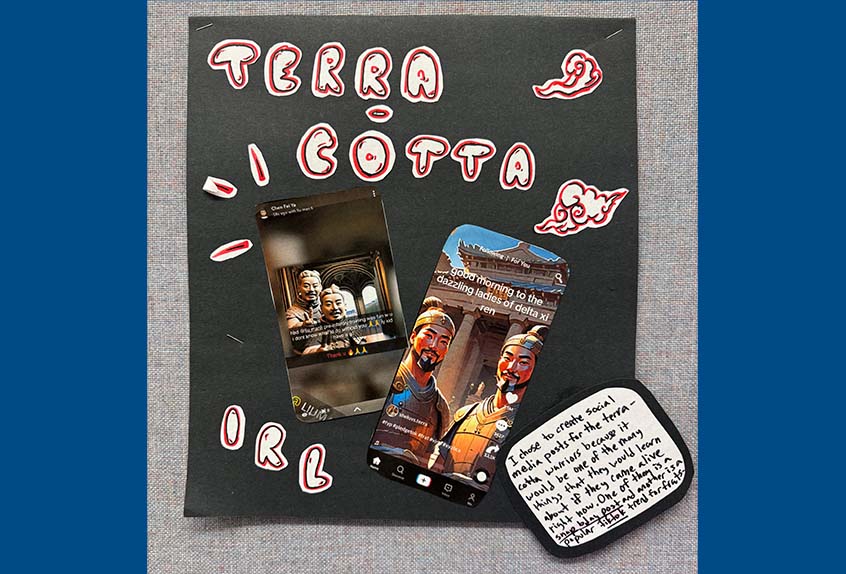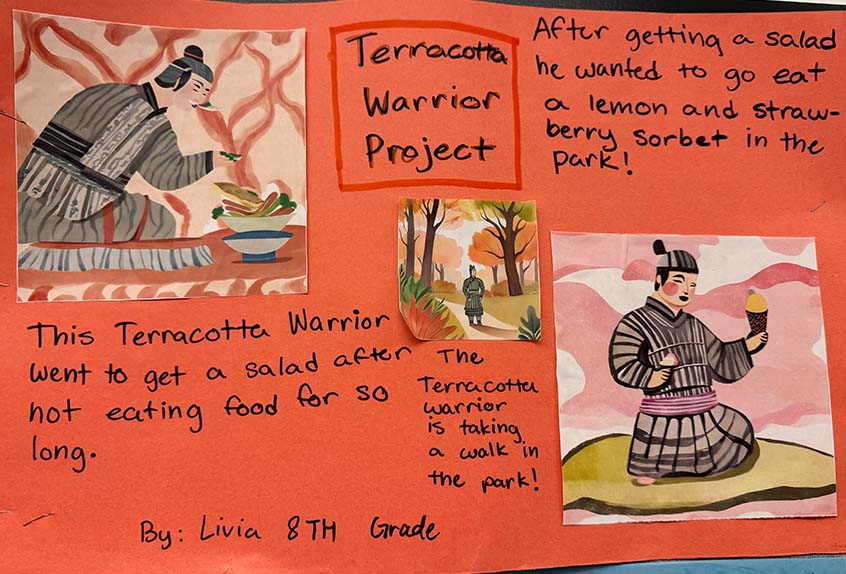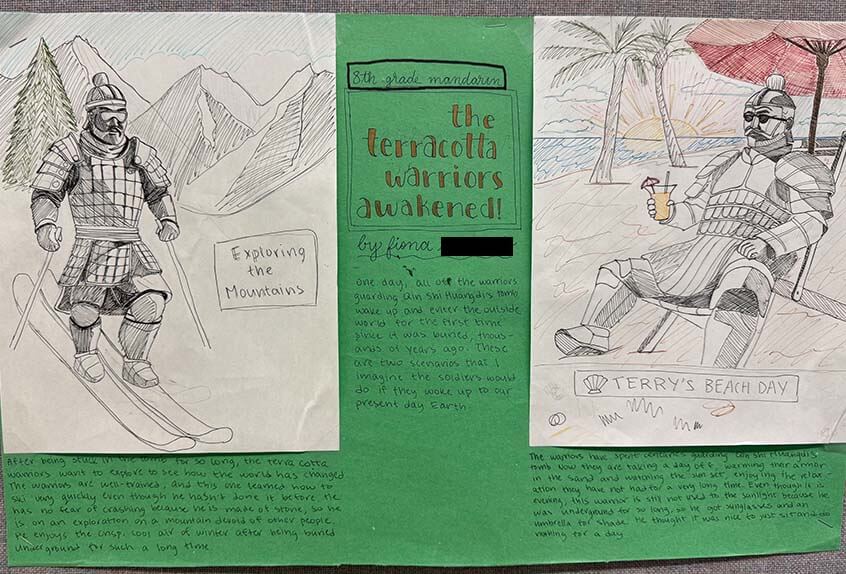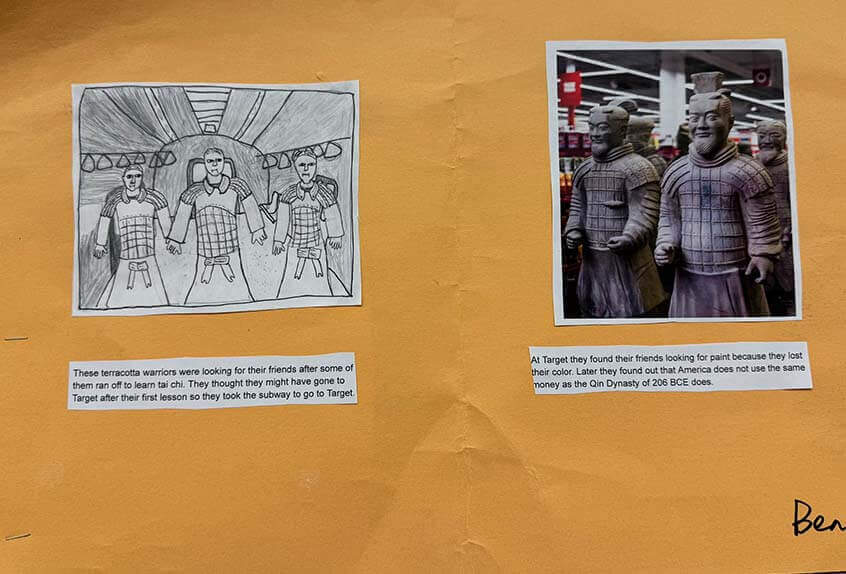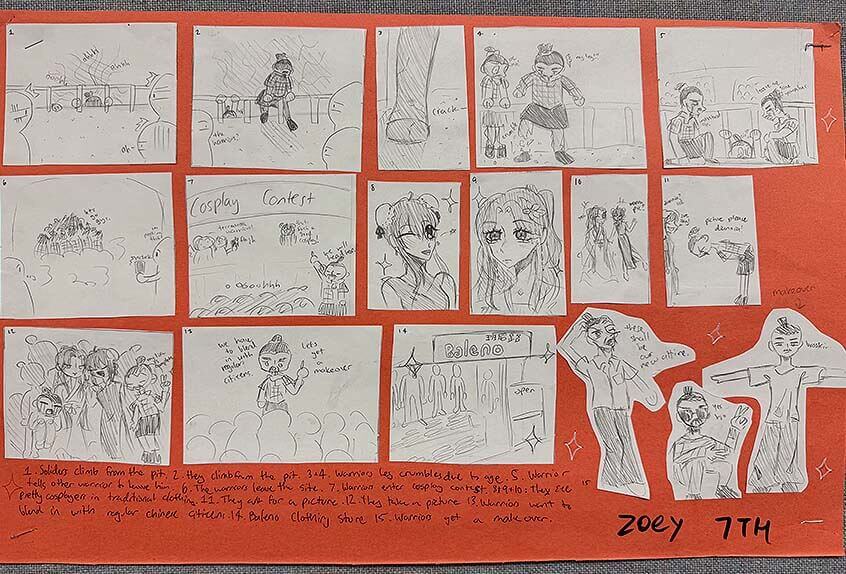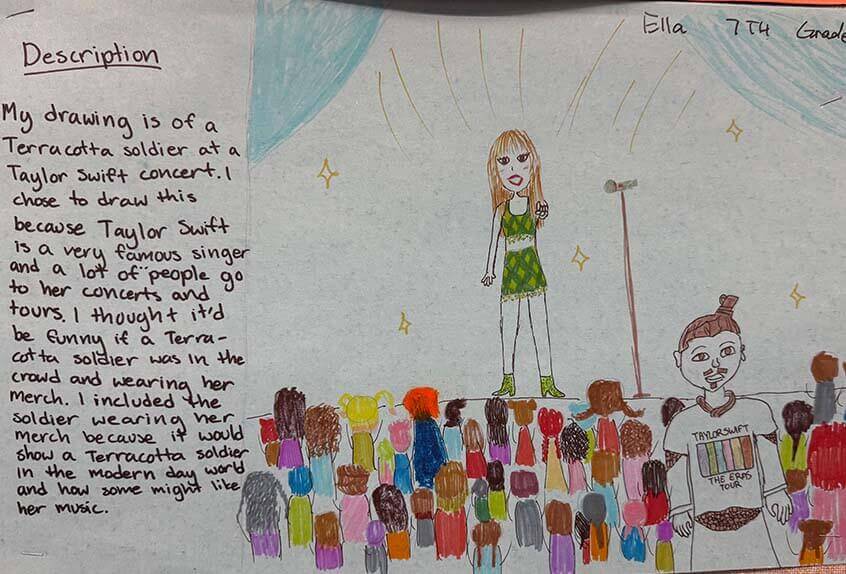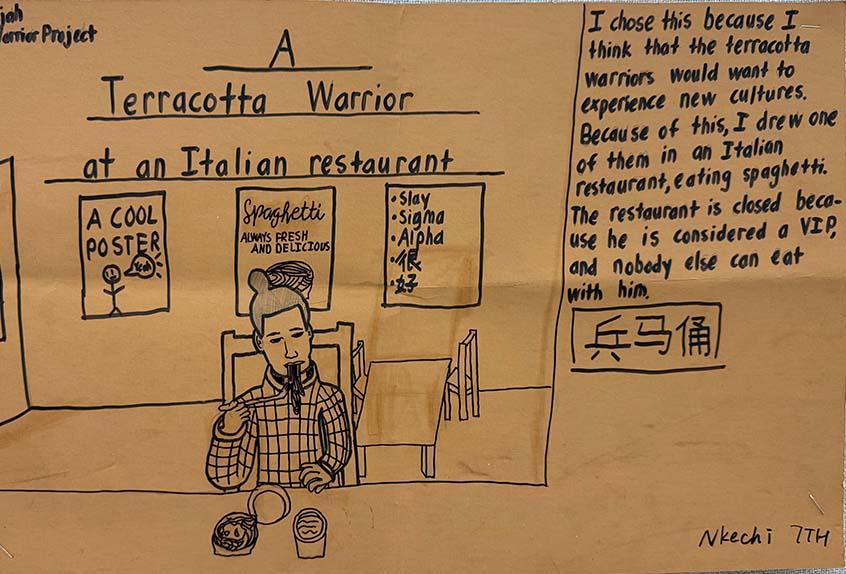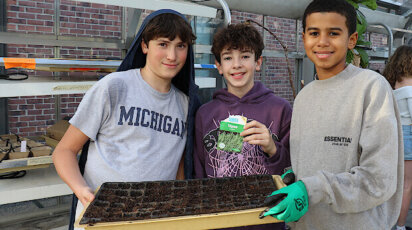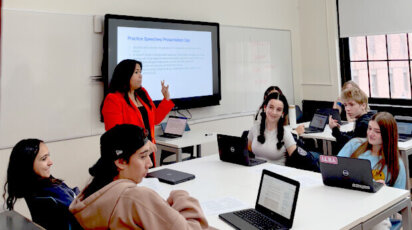News
A Look Inside Poly Middle School: Mandarin with Chenyi Zhou
Learning another language at Poly extends beyond textbooks and memorization. World Languages teacher Chenyi Zhou curates imaginative experiences in and beyond her classroom, deepening students’ cultural understandings. Enjoy this look inside her Middle School Mandarin classes in her own words!

By Chenyi Zhou
I firmly believe that language is more than just a communication tool—it is a vessel for national culture and a reflection of personal character and values. My goal is to help students not only develop their language skills but also cultivate openness to other cultures.
After two years of teaching, one question continues to challenge me: How can I effectively teach Chinese culture to Middle School students? How can I teach them to embrace a 5,000-year history with sensitivity and maturity?
This year, I explored new ways to collaborate with other Chinese teachers and schools, gathering diverse resources to enrich my students’ cultural learning. Additionally, I integrated multimodal activities to assess their cultural understanding, ensuring that learning goes beyond textbooks and becomes an interactive, meaningful experience.
Virtual Field Trips to Museums in China
In addition to in-class learning, students attended virtual field trips that took place on Friday evenings under the theme “Meeting the Terra-Cotta Army, Understanding Qin Culture.” These sessions were conducted in collaboration with Xidian University, the Terracotta Army Museum, Emperor Qinshihuang’s Mausoleum Site Museum, and the Museum of Bronze Chariots and Horses. Participation was voluntary, allowing students to join synchronously via Zoom and engage by asking questions in the chat. For those unable to attend live, recordings were assigned as part of their cultural learning.

One virtual field trip focused on exploring Pits No. 1, 2, and 3 of the Terracotta Army Museum. Professor Dong from Xidian University, alongside a professional tour guide, provided in-depth explanations about the historical significance of the terracotta warriors and their connection to the Qin Dynasty culture. A second virtual field trip took students to Emperor Qin Shihuang’s Mausoleum Site Museum, where they explored the legacy of China’s first emperor. Through this session, students gained a deeper understanding of the unification of the Qin Dynasty and the vast array of artifacts buried within the tomb, offering insights into the beliefs, technological advancements, and governance of the time.
Students noted that they really enjoyed getting up close and personal with the artifacts. The virtual trip sparked a fascination with ancient Chinese history after learning how powerful the Emperor and the nation once was. One student even reflected on feeling more invested in Chinese history after the virtual tours. “This virtual field trip made me far more interested in Chinese history, specifically unification, and how there have been so many different dynasties, unlike other countries which have been ruled by one family for thousands of years.”

Dual-Teaching Brings International University Professor to Poly
In addition to the virtual field trips, I introduced a new teaching approach: the Dual-Teacher Classroom mode. As part of this model, Luo Laoshi from Xidian University joined our class once per cycle via Zoom. Before each session, I collaborated with her to plan the lesson content. During class, Luo Laoshi engaged with students remotely while I facilitated in person.
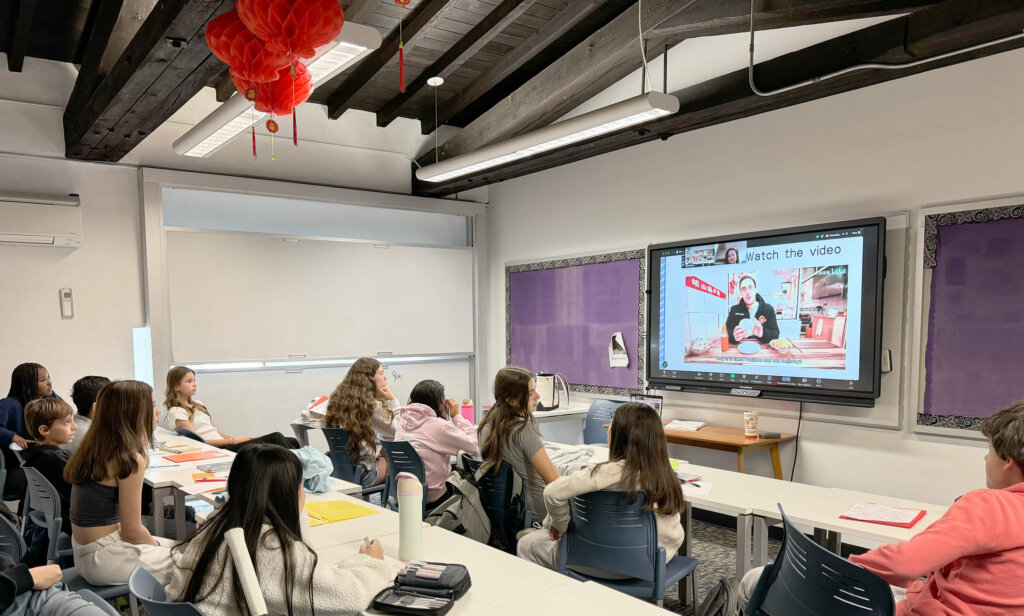
Her presence brought excitement, as students were eager to showcase their Mandarin skills in front of her. Together, we explored cultural topics such as traditional Xi’an cuisine, different flavor profiles, and ordering food. We also practiced calligraphy and painted Beijing Opera facial masks, making cultural learning more interactive and hands-on.
Additionally, the Dual-Teacher Classroom became a space dedicated to cultural lessons, and students even received their own Chinese names—an experience that deepened their connection to the language and culture.
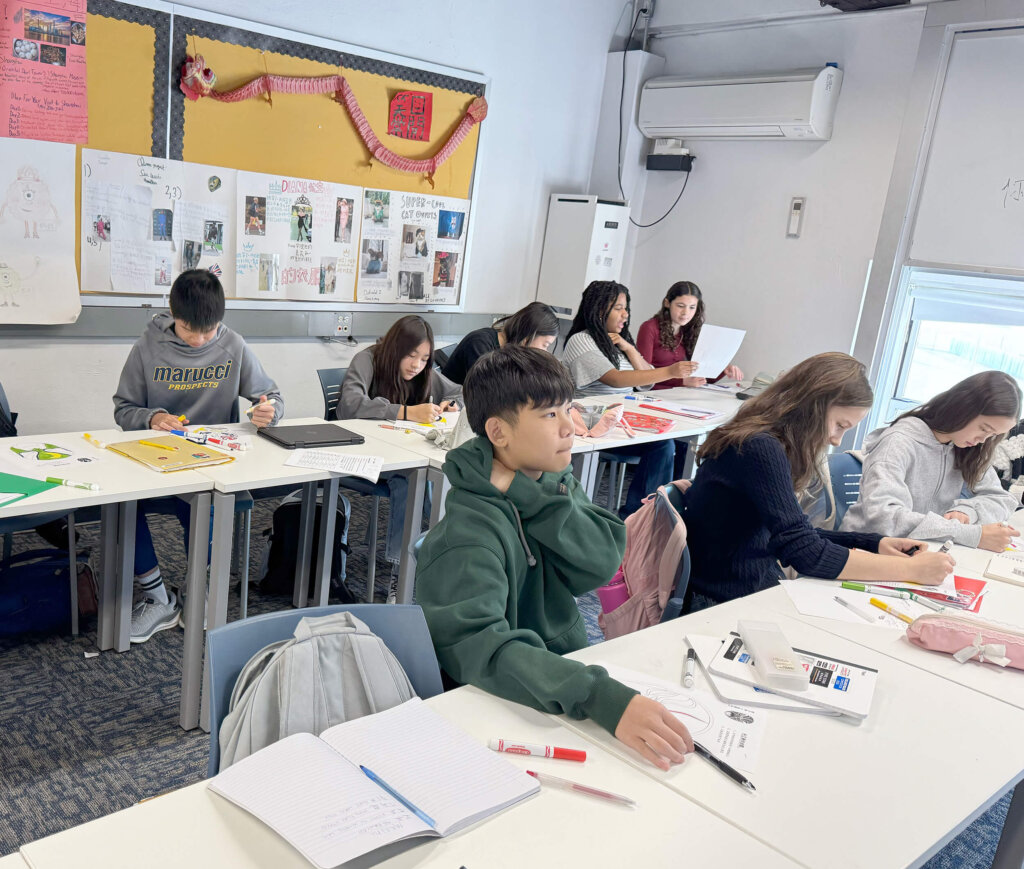
Poly Middle Imagines Terracotta Warriors Through Project Learning
After the first virtual field trip, students created a poster project about the Terracotta Warriors, integrating the knowledge they had gained. This activity was designed to actively engage students in historical exploration while fostering cultural awareness and motivation in their learning.
For the project, students were asked to imagine that all the Terracotta warriors came to life with the ability to speak. “What do you think they would do? Where would they go, and how would they act in the modern world?” Their creative and imaginative projects used drawing or collage to demonstrate their ideas, staying true to the characteristics of Terracotta Warriors with thought to the warriors’ clothing, possible behaviors and actions, and backstory. For inspiration, an example students were given to guide their final work was to show a Terracotta Warrior riding a motorbike in Times Square or giving a speech in front of the Eiffel Tower. Students created imaginative works of Terracotta Warriors on social media, riding the Coney Island Cyclone, shopping at Target, at a Taylor Swift concert, and many more.
Students noted that they felt free to embrace the project’s artful approach regardless of their experience with drawing or collage, with vocalized excitement to continue similar projects in the future. One student shared that they enjoyed the opportunity to exercise their creativity while bringing aspects of history into an imagined present. “I enjoyed the Terracotta Warriors project because it allowed me to combine creativity with what I learned. Drawing these ancient figures in a modern-day situation allows you to bring an aspect of the past into the present and see how it would work out. I also enjoyed this project because it allowed me to practice my drawing skills. I only used AI to generate the pictures but didn’t print them out; instead, I drew out a terracotta warrior from the generated image, which was much more interesting.”
A Day in the Qin Dynasty: A Storytelling Project for Grade 6
For the Grade 6 class, students created a cumulative storytelling project to demonstrate their cultural comprehension by reflecting on all they learned through the course’s hands-on activities and virtual field trips. Working in groups, students imagined what life might have been like for someone living in the Qin Dynasty, choosing any type of person to focus on, such as a farmer, soldier, artisan, noble, servant, or even Emperor Qin Shi Huang himself, with no limits on age, gender, class, or profession.
They then created artwork by drawing one or more pictures that illustrated a typical day in their chosen character’s life, ensuring their illustrations accurately reflected elements of Qin Dynasty life, including clothing, architecture, tools, and environment. Based on their drawings, students developed a three-minute story describing their character’s day, using storytelling to bring the scene to life by exploring the challenges their character faced, their daily routine, and their interactions with others. To complete the project, each group recorded a three-minute video or audio presentation explaining their artwork and narrating their story, ensuring historical accuracy by incorporating what they learned in class and conducting additional research as needed. The goals of the project were historical accuracy, creativity, and collaboration, providing students an opportunity to improve their presentation skills.
Cultural Video Project Improves Multimedia Skills
In Grades 7 and 8, students worked in groups to complete a cultural video project. As a whole, students selected a cultural topic to explore based on what they had learned from the virtual field trips and the Dual-Teacher classroom. This project allowed them to engage more deeply with Chinese history and culture while developing their collaborative and multimedia skills.
Each group created a 5-minute or more video organized around a specific topic from a virtual museum tour. The videos included an explanation of the chosen topic and its connection to Chinese culture, particularly in relation to the Qin dynasty, students’ interest in the topic, and the groups’ interpretation and understanding of the topic, demonstrating thorough research and using reliable sources.
Through this project, my goal is for students to enhance their cultural competence and digital literacy while fostering creativity. They are responsible for researching their chosen topics, drafting outlines and scripts, recording footage, and creatively editing their videos. This process not only deepens their understanding of Chinese culture but also helps them develop research, storytelling, and multimedia skills.

